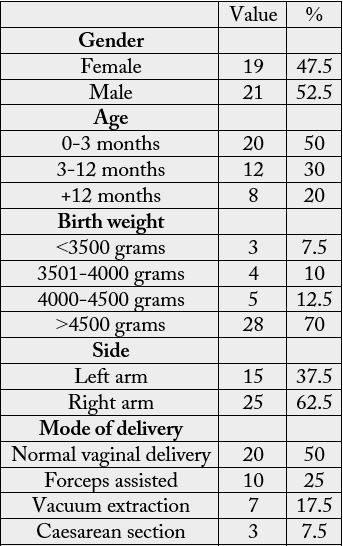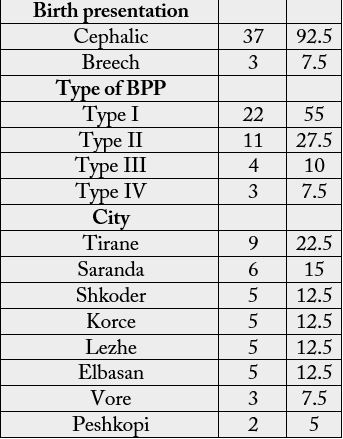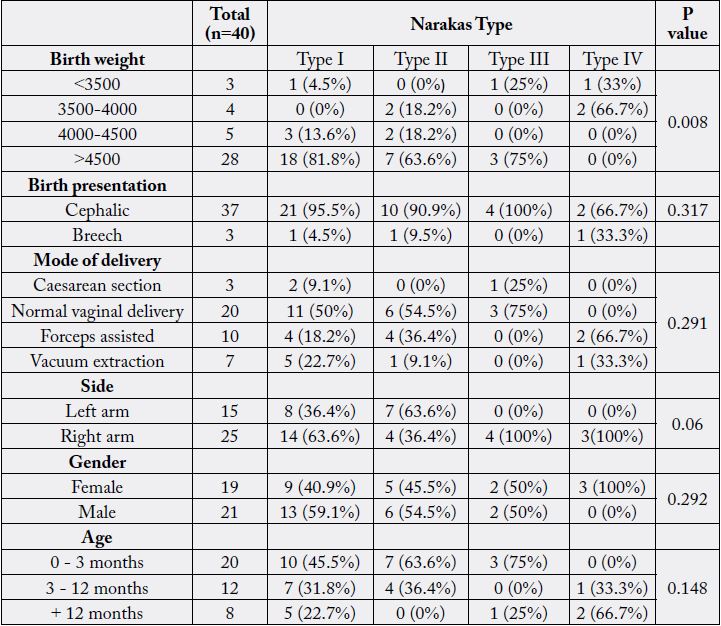Biography
Interests
Lindita Vata
Department of Pediatric Physiotherapy, Mother Theresa University Hospital Center, Albania
*Correspondence to: Dr. Lindita Vata, Department of Pediatric Physiotherapy, Mother Theresa University Hospital Center, Albania.
Copyright © 2020 Lindita Vata. This is an open access article distributed under the Creative Commons Attribution License, which permits unrestricted use, distribution, and reproduction in any medium, provided the original work is properly cited.
Abstract
Brachial plexus palsy (BPP) is a complex complication of delivery. The clinical course according to
symptoms may be either intermittent or progressive in patients with BPP. Total brachial plexus palsy
is typically manifested with compromised hand, shoulder and arm function. Thus, an important
component of successful management of the disease is physiotherapy. In the literature there are not
studies published for BPP in Albania. With this in mind, we undertook this study to estimate a
description of BPP in Albania.
To study and emphasize, feature, main factors that affect brachial plexus palsy, especially importance
of early diagnosis and involvement of physiotherapist.
40 children with BPP treated between 2014-2019 at the physiotherapy Department of the
University Hospital Center "Mother Teresa", were included. Statistical processing was conducted
with IBM SPSS version 20.
Interestingly we found that there was a significant positive correlation between BPP type and birth
weight of study patients.
BPP may be recognized, treated and adverse sequelae of BPP prevented with the earliest involvement
of the physiotherapist in neonatal units. Investigation of patients with increased risk of BPP and
estimation of the prevalence of neonatal BPP in Albania are reserved for future work.
Introduction
Brachial plexus palsy (BPP) is considered a health concern, that might cause lifelong problems for infants.
Currently, most researchers believe that the main cause of the disease has been attributed to the injury of the
cervical roots C5-C8 and thoracic root T1 [1,2] during the neonatal period [1-7].
The timely involvement of a physiotherapeutic in the post-delivery period for children with obstetric brachial plexus palsy may greatly enhance the effectiveness of OBPP prognosis and treatment in order to achieve maximal results.
Objectives of physiotherapy are to prevent joint stiffness or contractures in the early phase and physiotherapy has beneficial effect on reducing handicaps in daily living.
The prevalence of BPP ranges globally from 1.6 and 2.6 in 1000 births [4,8,9-11]. The type of obstetric care and the average birth weight of infants in different geographic regions have an effect on the prevalence rate [8,12-20]. To our knowledge, for Albania there are no data for BPP, therefore the aim of our study was to evaluate a description for BPP in Albania on a period of 5 years. The aim of this study is to emphasize, feature, main factors that affect brachial plexus palsy, especially importance of early diagnosis and involvement snf follow up of physiotherapist.
Material and Methods
This study was realized at the physiotherapy Department of the University Hospital Center "Mother Teresa",
the main referral Centre for Albanian country. We retrospectively studied 40 patients treated during the
time period of 2014 - 2019. The study involved all children 15 years and below who have been diagnosed
with brachial plexus birth palsy and attended the physiotherapy department of the UHCT within the study period. Because the physiotherapy department of the UHCT treat children within this age group, we decide
to use this age category. The following information was abstracted from the patients’ medical records: gender,
age, birth weight, mode of delivery, city of delivery, side of affectation, the BPP type, presentation at birth.


The data collected were entered into IBM SPSS version 20.0 (Statistical Package for the Social Sciences, Chicago, IL) analyzed using descriptive statistics. All calculated p values less than 0.05 were considered significant. For continuous variables, descriptive statistics such as means and SDs were calculated. A Chisquare test was performed for nominal or ordinal variables.
Results
19 (47.5%) of 40 patients were female patient with brachial plexus injuries and 21 (52.5%) were male
patient. There was half of brachial plexus injuries 50% (n=20) within the age category (0-3 months), 30%
(n=12) within 3-12 months age category and 20% (n=8) within the +12 months age category. Patients on
an average had high birth weight (>4500grams), whereas the overall mean birth weight was 4595g (SD =
611.82).
25 (62.5%) patients were diagnosed with right arm injured, and 15 (37.5%) with left arm affected. 20 patients (50%) were delivered through normal vaginal delivery, 3 (7.5%) through caesarean section, 10 (25%) with forceps assisted, 7 (17.5%) with vacuum extraction. An examination of the birth presentation showed that women had at term cephalic and breech presentation with 92.5% and 7.5%, respectively.
Features of BPP of patients were divided into four types based on classification proposed by Narakas [21]. From the total number of patients with BPP, a larger number of patients, 55% belong to the type I paralysis, 27.5% to type II paralysis, 10% to type III paralysis and 7.5% to type IV paralysis.
Patients were further classified according to city of delivery, the largest percentage of patients were from Tirana, the capital city of Albania 22.5%.
We division the patients by birth weight and presentation for each Narakas type (table 2). The relation between birth weight and Narakas type was significant, whereas the relation between birth presentation and Narakas type was not significant.

Discussion
Patients frequently identified with type IV of BPP were significantly more likely to have a birth weight
between 3500grams and 4000grams. These results are in accordance with earlier studies [5,6,13-16,19,20].
There were no specific risk factors such as: gender, birth presentation, side, mode of delivery, city of delivery, risk factors significantly associated with the BPP type.
The most important limitation of our study is limited patient sample size, therefore this can be the reason of statistical differences observed between the BPP types regarding correlation with above risk factors.
In addition, up to 92.5% of infants with BPP were born cephalic and 7.5% of them were born breech but there was no significant difference between the BPP type of the two groups of birth presentation.
As we can see that the right side has an advantage over the left side in patients with BPP and is worth to highlight a significant relation of both sides with the type I of BPP (p=0.06). We did not identify any patient with both arms affected.
We aware that our research may have a number of limitations that could have influenced the results obtained. To begin with the difficulties to insure a large number of patients, as a cohort. In addition, the lack of a more detailed clinical record form for objective and physical examination for each patient before, during and after birth. Finally, we believe that an important issue is the absence of a common protocol for the follow up of BPP.
Future studies are therefore required to identify high-risk patients to estimate at time diagnosis and treatment of them in order to reduce the risk and to inhibit adverse of health outcomes.
Conclusion
This study is the first of its kind to document the descriptions of neonatal BPP in Albania. BPP may be
recognized, treated and adverse sequelae of BPP prevented with the earliest involvement of the physiotherapist
in neonatal units. Investigation of patients with increased risk of BPP and estimation of the prevalence of
neonatal BPP in Albania are reserved for future work.
Acknowledgements
The author has declared that no competing interests exist.
Funding Information
This research did not receive specific grant from any funding agency in the public, commercial or not-forprofit
sectors.
Bibliography

Hi!
We're here to answer your questions!
Send us a message via Whatsapp, and we'll reply the moment we're available!